When trying to lose weight, it can be helpful to have a support system. That’s where weight loss blogs come in.
People learn how to best manage their own weight by reading from other people’s experiences and advice.
If you have knowledge or experience when it comes to weight loss, why not start your own blog to help others who are on their own weight loss journey? You could be a personal trainer or someone who has personal experience losing weight.
In this post, we’ll teach you how to start a weight loss blog and make money online while doing it in this step-by-step guide.
So what are you waiting for?
Let’s get started!
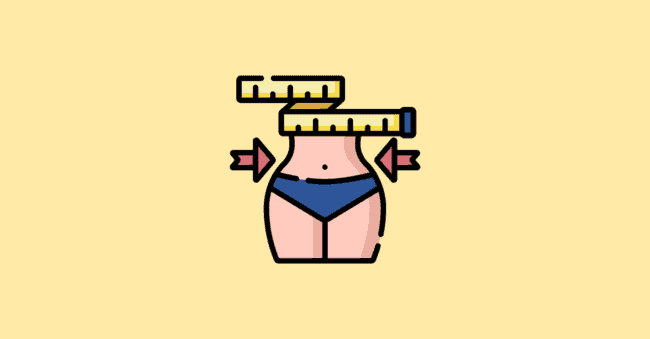
How to Start a Weight Loss Blog in 7 Steps
- Define Your Weight Loss Blogging Goals
- Choose a Weight Loss Niche
- Pick & Register a Blog Domain Name
- Setup WordPress
- Write & Publish Blog Posts
- Promote Your Weight Loss Blog
- Monetize & Make Money
1. Define Your Weight Loss Blogging Goals
The first step to starting any blog is to define your goals.
Why do you want to start a weight loss blog?
Are you looking to:
- Help people lose weight
- Share your own weight loss journey
- Offer tips and advice on how to best lose weight
- Become an influencer
- Make Money
Your answer will help determine the focus and content of your blog.
What is a Weight Loss Blog?
A weight loss blog is a blog that focuses on helping people lose weight. Weight loss blogs offer advice, tips, tricks, and support to help people reach their weight loss goals. These blogs can be personal or collective experiences, how-to guides, or a mix of both.
Why Start a Weight Loss Blog?
There are many reasons why you might want to start a weight loss blog.
Maybe you’re looking to:
- Help others lose weight
- Share your own journey and inspire others
- Offer tips, tricks, and advice on how best to lose weight
- Make some extra money on the side through monetization methods like advertising or affiliate marketing
The benefits of starting a weight loss blog include:
- Become an authority and expert in weight loss
- Make money with your weight loss knowledge, experience and expertise
- Help others achieve their weight loss goals
- Inspire and motivate people with your own weight loss journey
There are numerous other reasons why you might want to start a weight loss blog.
But ultimately, it all comes down to what YOU want to get out of starting a blog.
How much money can you make from weight loss blogging?
You can make $15-$25 for every 1000 ad views on your weight loss blog. An SEO optimized blog post can get anywhere between 300 to 1000 visits per month. So, a weight loss blog with 100 blog posts can make as high as $2500 every month. You can make even more money if you monetize with affiliate marketing and digital products.
2. Choose a Weight Loss Niche
Now that you know why you want to start a weight loss blog, it’s time to choose your niche.
Your niche is the specific focus of your blog. It’s what makes your blog unique and different from other weight loss blogs out there.
Why choose a niche?
Choosing a niche allows you to be specific with your content. It gives you direction and focus for your blog. And ultimately, it allows you to better serve your target audience.
You can appeal to a targeted audience of weight loss readers who are interested in your specific niche.
You will also be able to rank better in search engines because you’re targeting specific keywords related to your niche.
Most importantly you will be able to build a strong and loyal following because you’re catering to a specific group of people with similar interests.
How do you find your niche?
There are a few ways you can go about finding the perfect weight loss niche for your blog.
To find your niche, ask yourself these questions:
- What topics are you passionate about?
- What do you have experience with?
- What do you want to learn more about?
- Who is your target audience?

For example, if you’re passionate about healthy eating on a budget, your niche could be healthy eating on a budget.
Your target audience would be people who want to eat healthy but are on a tight budget. And your content would focus on tips, tricks, and advice on how to eat healthy without breaking the bank.
Another example could be if you want to share your own weight loss journey and inspire others.
In this case, your niche would be documenting your own weight loss journey and your target audience would be people who are struggling to lose weight and are looking for motivation and inspiration.
There are many different niches you can choose from within the weight loss industry. Here are a few examples:
- Vegan weight loss
- Weight loss for men
- Christian weight loss
- Holistic weight loss
- Keto dieting
- Healthy eating on a budget
- Weight loss for seniors
- Weight loss for women over 50
- Vegetarian weight loss recipes
- Weight loss tips for busy moms
Come up with a few niche ideas.
Avoid YMYL Niches
There are certain niches that you should avoid if you want to make money with your blog. These are called high-risk or Your Money Your Life (YMYL) niches.
YMYL niches are those where the advice you give could have a direct impact on someone’s health or wealth. This will include topics that are medical or investing advice.
If you choose a YMYL niche, you will have to put in a lot more work to get your blog ranking in the search engines. This is because Google has strict guidelines when it comes to YMYL blogs. You will need a lot of authority and credentials like a medical degree to be able to rank for these terms.
Search keywords in your niche and if you only see blogs like Health Line and WebMD rank for your keywords, then you are in a YMYL niche which you must avoid.
For example, Keto Diet is a YMYL niche but if you write about Keto Breakfast recipes, it is not YMYL. So choose your niche carefully to ensure it is not medical information.
If you do choose to write articles in the YMYL space, make sure you reference scientific journals and papers and back up all your facts and claims.
Examples of Weight Loss Blog
Sometimes looking at other weight loss blogs will help inspire ideas of your own. Here are some of the more popular examples of weight loss blogs:
1. The Healthy Foodie
The blog focuses on healthy eating and has recipes for nutritious meals that are also tasty. The author also shares tips on how to eat healthy on a budget and how to make healthy choices when eating out.
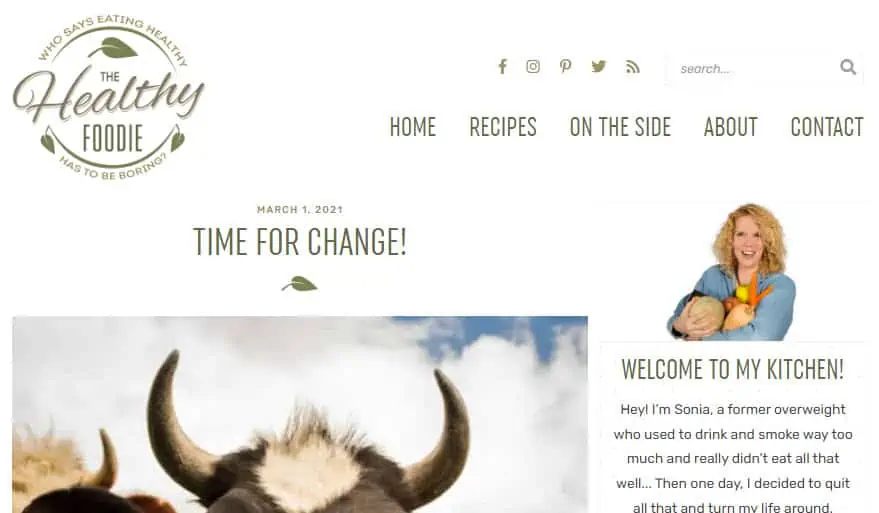
2. Fit Mother Project
This blog is aimed at busy moms who want to get in shape but don’t have a lot of time to work out. The author shares quick and easy workouts that can be done at home with minimal equipment.
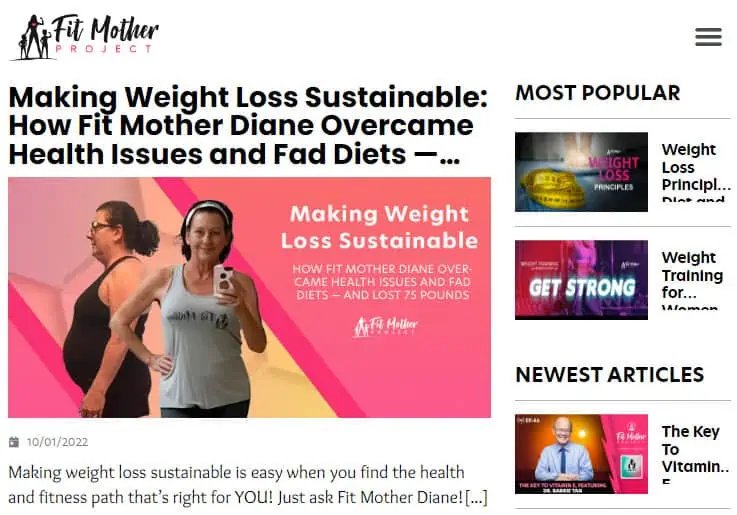
3. Sexy Fit Vegan
This blog is devoted to helping vegans lose weight in a healthy way. It has vegan recipes, meal plans, and advice on how to make veganism work for weight loss.
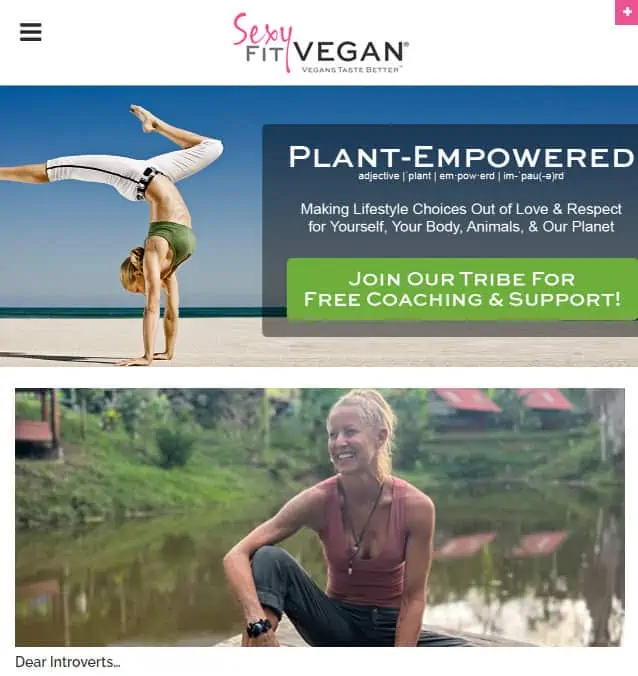
4. Slimming World
This blog is all about how to make small changes in your lifestyle that will lead to big results. It has advice on exercise, nutrition, and mindset shifts that can help you reboot your body and lose weight.
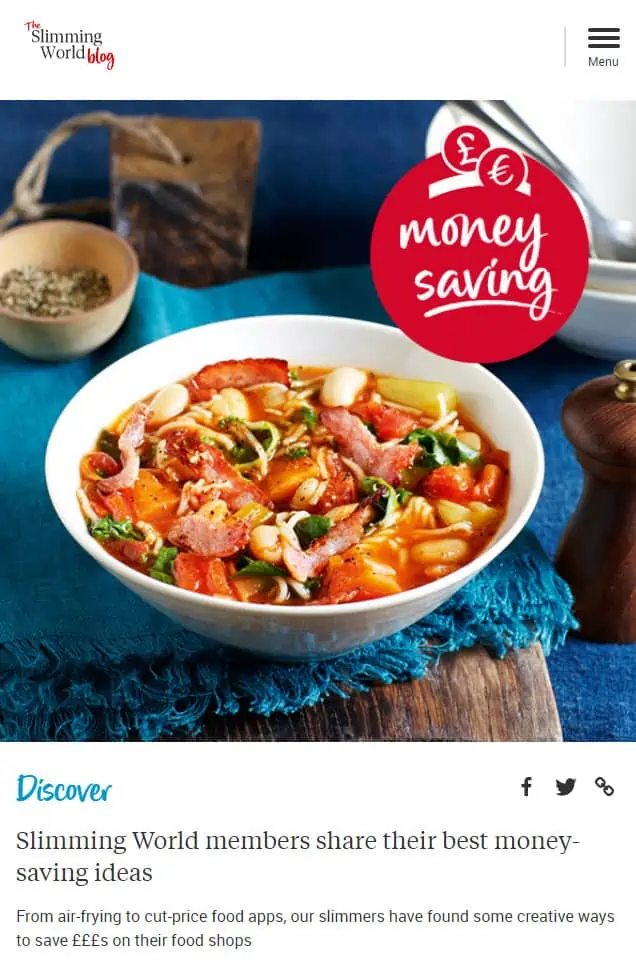
5. KetoGasm
This blog is devoted to helping people lose weight through keto dieting. It has keto recipes, meal plans, and advice on how to make the keto diet work for weight loss.
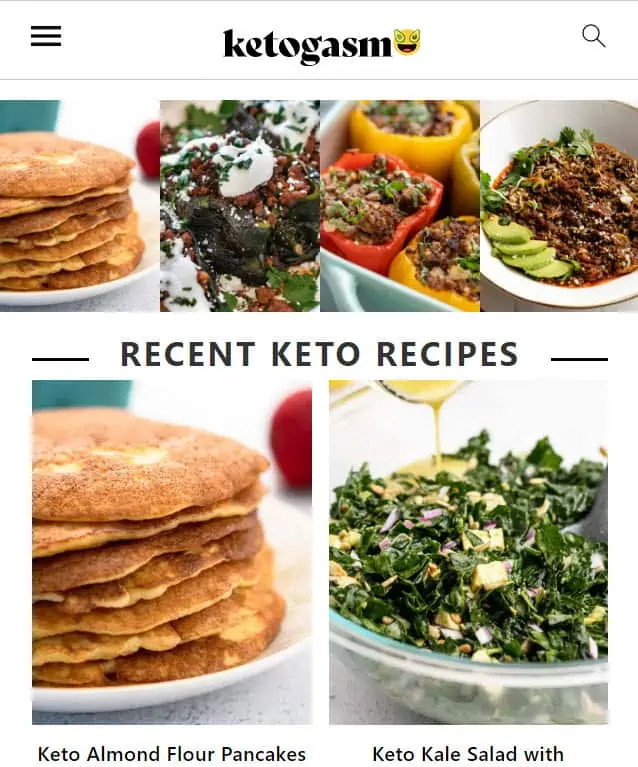
3. Pick & Register a Blog Domain Name
Once you have chosen your niche, it is time to brainstorm a few names for your weight loss blog.
We recommend you keep your weight loss blog’s name to two words (Example: Workout Mommy). One of the two words should be a keyword from your niche. The other word can be something that makes your website brandable. For example, our blog teaches people how to make passive income, so we have named it Passive Book.
Here are some of the words that you can mix and match into your blog name:
- Vegan
- Keto
- Workout
- Fit
- Fitness
- Mommy
- Paleo
- Eat
- Weight
- Lean
- Healthy
- Thin
- Fat
- Slim
- Meal
Use a Business Name Generator to brainstorm the name of your blog.
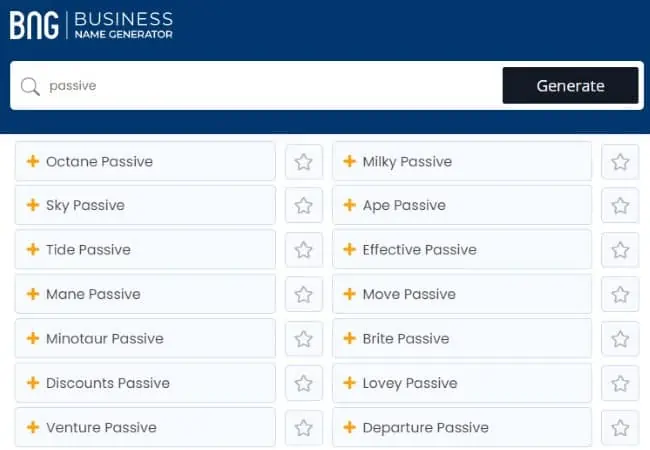
You can also use your own name for your blog. But if you ever plan to sell your website in the future, it is much more difficult to transfer your brand to the buyer when it is your name.
Check Domain Name Availability
After you have brainstormed a few names for your weight loss blog, you should check if the .com domain name is available.
A blog’s domain name is the web address of your website. It is the first thing people will see when they type your website into a web browser, so it is important to choose a domain name that accurately represents your blog.
You must check if both the .com domain name and the social media handles are available. You can use Namechk to check the availability of both your domain name and social media handles.
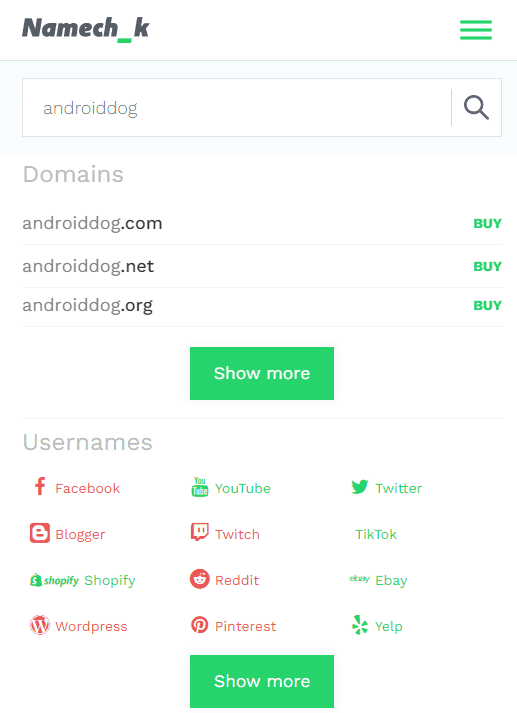
Here are a few things to keep in mind when selecting a domain name:
- Choose a .com domain name. 86% of the internet uses .com, so your visitors are likely to try visiting your blog by typing .com. Avoid other extensions like .net or .org.
- Don’t include hyphens and numbers.
- Do not use words with multiple spellings (for example colour vs color).
- Shorter domain names are better. Try to keep it under 12 characters.
- Spelling & Pronunciation should be easy and intuitive.
- It should be easy to remember.
- Avoid words that can be misread together. For example, therapistjohn.com can be read as Therapist John or The Rapist John.
- Make sure it’s not trademarked or copyrighted by someone else. The AI writing software Jarvis.ai had to rebrand to Jasper.ai because Marvel sued them for the Iron Man reference. Lawsuits will happen once your blog is established.

Register a Domain Name
Once you decide your domain name it is time to register it.
You should register your domain with NameCheap because you will get domain privacy for free. Other providers charge $12 per year for domain privacy. Without domain privacy, your name, home & email address will be accessible to the public.
Step 1: Go to NameCheap. Enter your domain name with the .com extension.
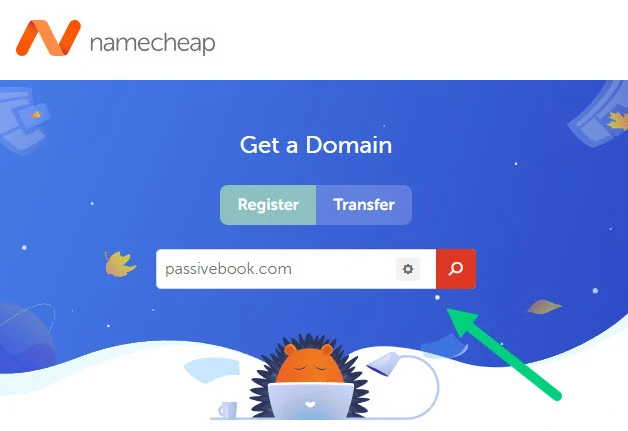
Step 2: Select the .com extension and click the Add to Cart button.
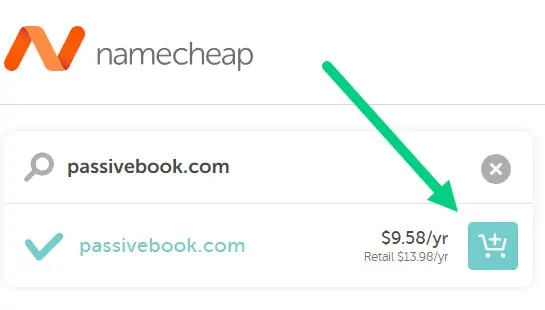
Step 3: After adding the domain to the cart, click on the Checkout button.

Step 4: Enable Domain Privacy that comes for free along with auto-renew. You don’t need any other paid addon.

Step 5: Click on Confirm Order. Pay to complete your purchase.
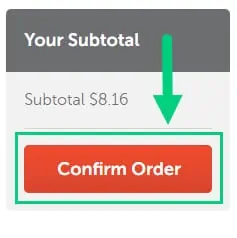
Step 6: Log in to Namecheap and click on Domain List ❶ in the left sidebar and then click Manage ❷ next to the domain you just purchased.
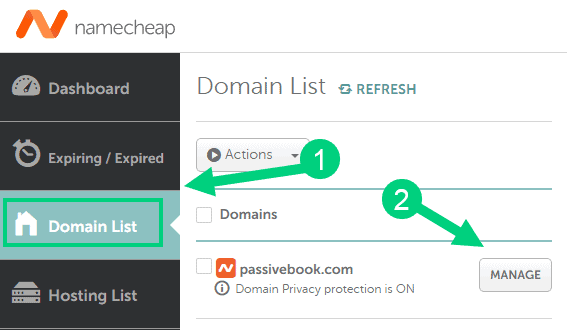
Step 7: Under the Nameservers section, select “Custom DNS” from the dropdown ❶. Then enter the following two nameservers ❷ ns1.bluehost.com and ns2.bluehost.com as shown in the image. Then click the green tick ❸ to save. If you use a hosting provider other than Bluehost, enter their nameserver values in this step instead.
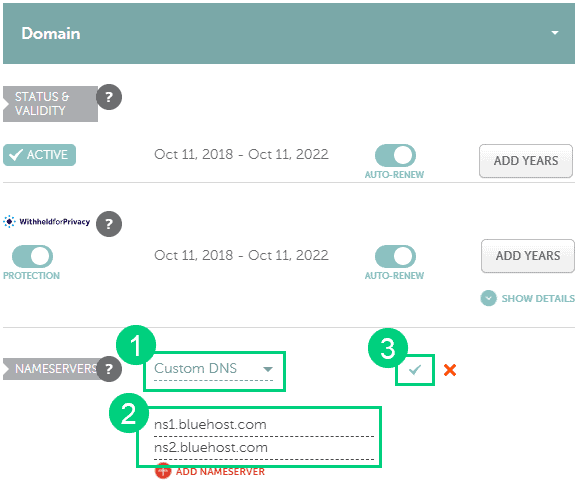
Can I get a free domain name?
Your web hosting provider might give you a free domain name for one year but they charge $12 for domain privacy which is free in Namecheap. From the second year, you will pay for both the domain and privacy which will cost you more than $20+. So it is cheaper to just register your domain with Namecheap from the beginning. Also using different companies for web hosting and domain registration will allow you to easily switch your blog host later without transferring domains.
Can I change the name of my blog later?
You will lose your search engine rankings if you change your blog’s name once it gets links from other websites. It will take as long as a year or more for you to regain the lost traffic. It is possible to mitigate problems by having proper redirects. But you will have to renew both your old and new domains every year. So try to avoid changing your blog’s name once it is established.
4. Setup WordPress
Now that you have chosen a niche and a domain name for your weight loss blog, it is time to set up your website. We recommend using WordPress which is a free and open-source content management system (CMS) that you can use to create a website or blog.
Why Choose WordPress.org?
There are many blogging platforms but the self-hosted wordpress.org powers 70% of blogs on the internet. 42% of all websites on the internet use WordPress. It is by far the most popular blogging platform.

The main reasons people choose WordPress are:
- It’s free to use in a web hosting of your choice.
- You can create any type of website with WordPress.
- It’s easy to use and you don’t need to know how to code.
- It’s very customizable with themes and plugins.
- It has great support from the WordPress community.
- You own your website and data.
WordPress.org vs WordPress.com
There are two versions of WordPress: WordPress.org and WordPress.com.
WordPress.org is a self-hosted platform which means you need to sign up for web hosting and install WordPress on your own server. This gives you full control over your website and you can make money from your website as you please.
WordPress.com is a hosted platform which means you don’t need to worry about hosting or installing WordPress. But the website will not rank in search engines. You are also limited in how you can make money from your website.

If you want to make money from your blog and drive traffic, we recommend self-hosted WordPress.org.
Why Avoid Free Blogging Platforms
There are many free blogging platforms such as Blogger, Medium, Wix, and Weebly. While it might be tempting to use a free platform because it’s free, we recommend avoiding them for the following reasons:
- It’s harder to drive traffic to a free platform because they are not optimized for search engines and will not rank in Google.
- You are limited in how you can make money from your website.
- They are not as customizable as WordPress.org.
- You don’t own your website or data. The platform can delete your website at any time without notice.

How much does it cost to start a weight loss blog?
It will cost you $2.95 per month to host your WordPress weight loss blog in Bluehost. A domain will cost you $12/year. So that is a total of $4.2 per month, which is less than the price of Netflix for all the unlimited features that a self-hosted WordPress blog has to offer.
What to do if you already have a free blog?
Migrating from a free blogging platform to WordPress can be easy using a free import plugin.
The plugin will import your content from a free blogging platform to WordPress. It automatically sets up all your posts, pages, comments, and images as new posts and pages on your WordPress site.
Install WordPress in Hosting
The first thing you need to install WordPress is web hosting. Web hosting is a service that provides a platform for your website to be accessible on the internet.
If the domain name is the address of your business, web hosting is the land where your business is built.
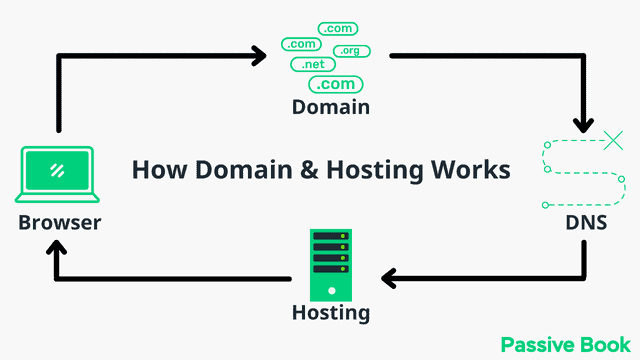
For this guide, we will use BlueHost as our web host. It is a cheap hosting that is extremely easy for beginners to set up. If you use any other web host, the steps will be the same but the user interface may be slightly different.
1. Go to BlueHost using this link to get a special discount. Select WordPress > WordPress Hosting from the top menu.
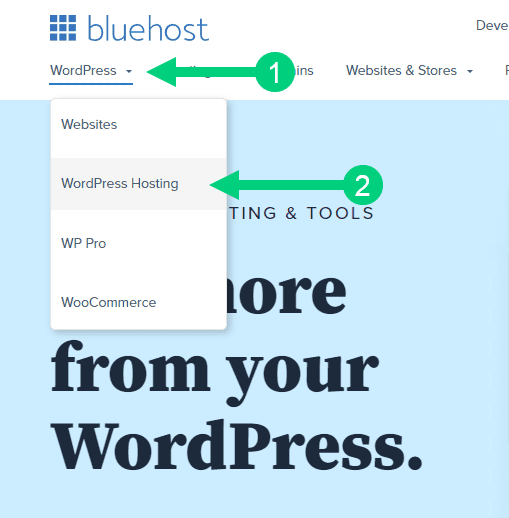
2. Click on the button you see on this page and you will be taken to the pricing section.

3. Select the Basic Plan. You can upgrade to a different hosting plan as you grow.
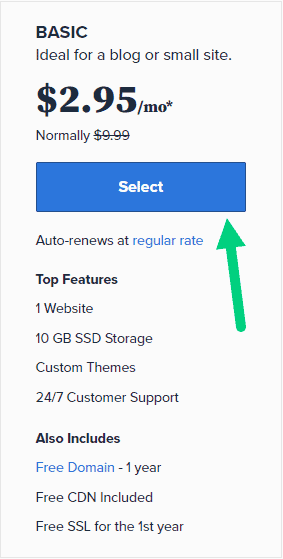
4. If you already have a domain name that you purchased with Namecheap you can put that in the “Use a domain you own” ❶ section. If you don’t have a domain name yet, choose the “Create a New Domain” ❷ to purchase a new domain.
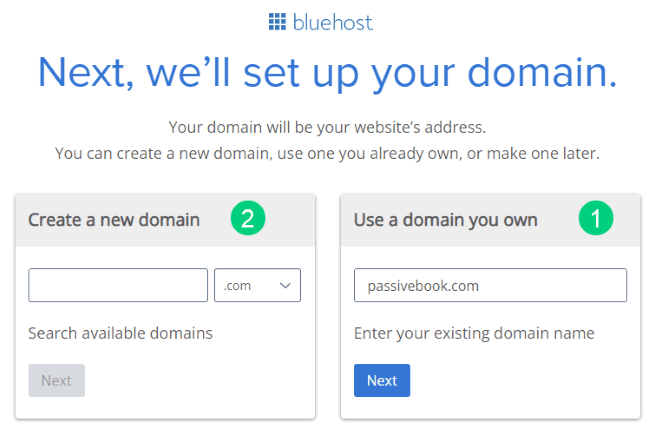
5. In the next screen, enter your information. Uncheck all package extras. If you purchase your domain through Bluehost instead of Namecheap, you may want to enable Domain Privacy. You won’t see the Domain Privacy option if you bought your domain through Namecheap. Namecheap will give you this Domain Privacy for free.
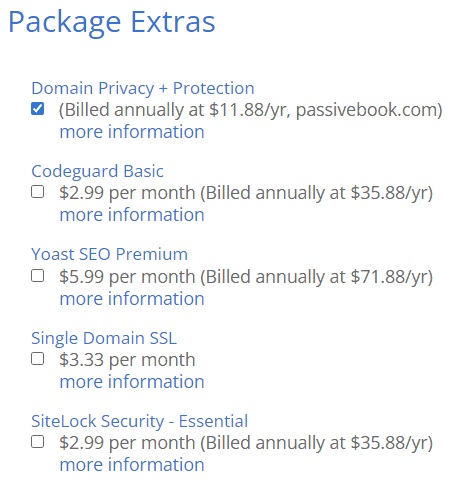
6. Once you have successfully paid, you will be prompted to set a password. Click on the “Create your Password” button.
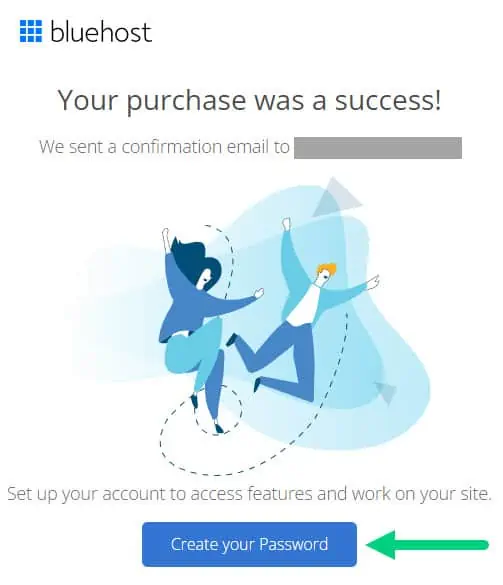
7. Enter your password and create your account. If you lose this password, you can reset it.

8. After you set your password, log in to Bluehost.
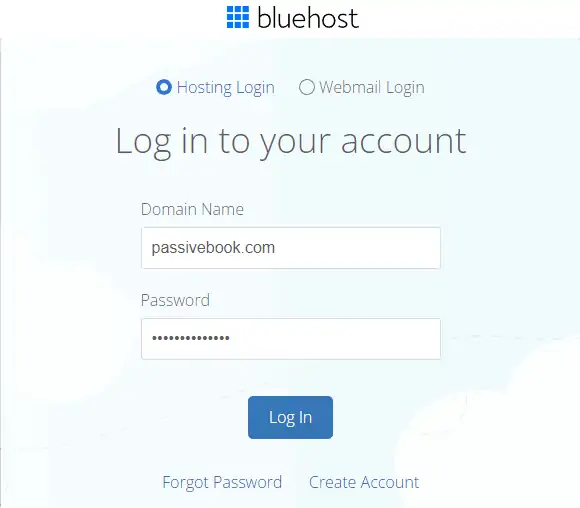
9. Click on the Create your website button on the following screen. This will start a Bluehost Wizard, just click Skip this step wherever possible.

10. On the following page, click “No help needed” or “Skip this step”. We don’t want Bluehost to limit our customization options.
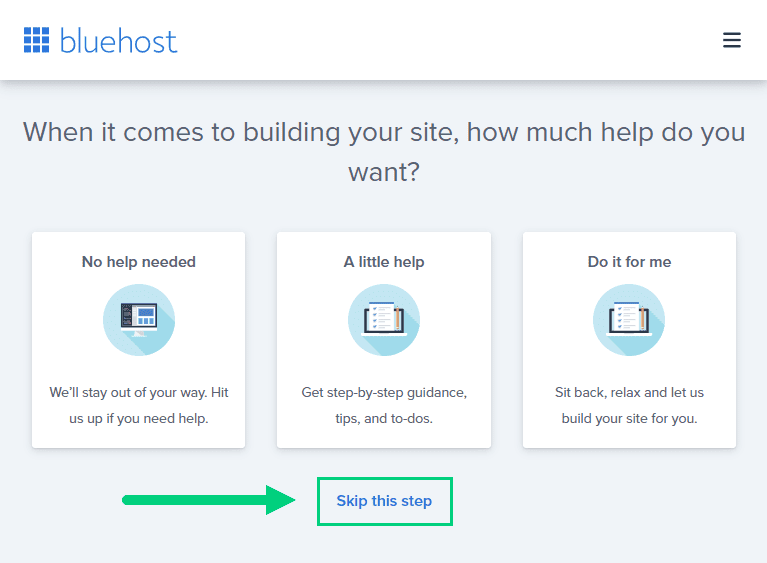
11. On the next page, you will be asked about the purpose of your website. You can choose from any of the available options.
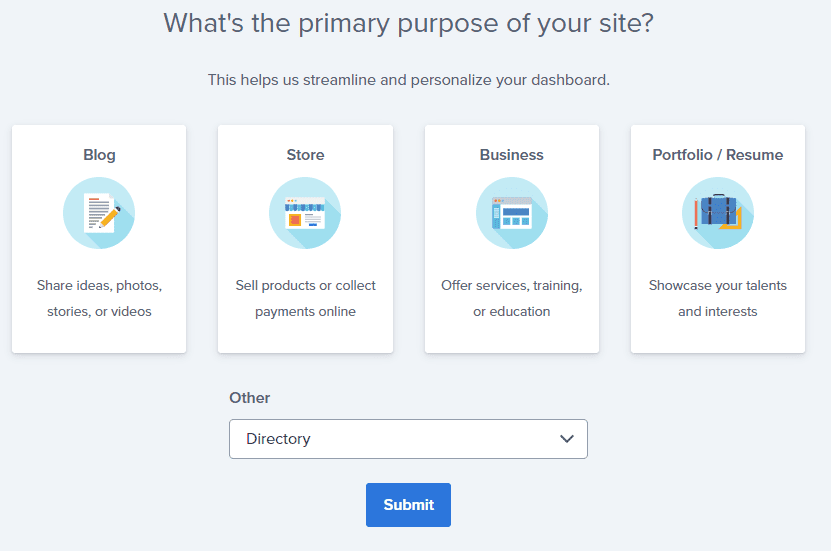
12. On the next page, click Skip this step.

13. On the following page, enter the blog’s name and tagline. You can change this later so feel free to click “Skip this step” or enter something as a placeholder and click Continue.
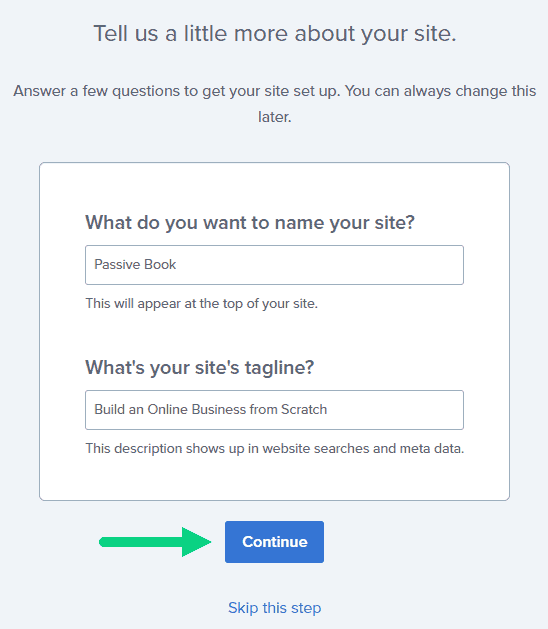
14. Finally you will be asked how you want to build your website. Choose “Limitless customization” to have all the options.
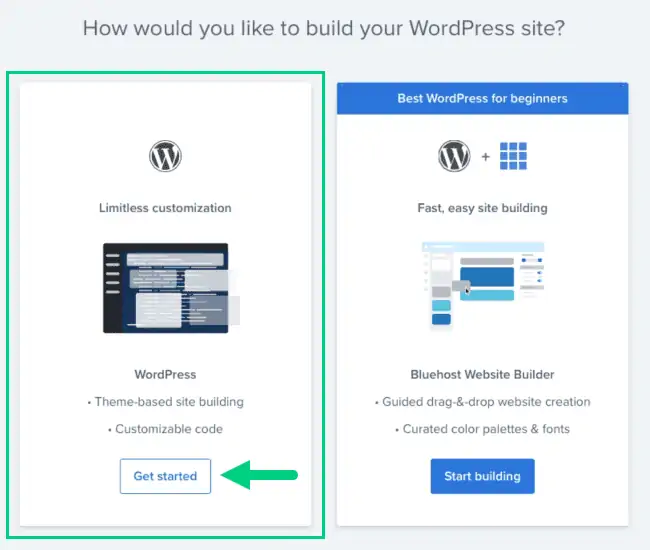
15. You can see your blog by going to yourdomain.com. Go to the Bluehost dashboard and click on the My Sites tab ❶ in the left sidebar and click on the “Manage site” button ❷.

16. Your WordPress site has separate login credentials different from the ones you use to log into Bluehost. You can use this to log in to the WordPress dashboard directly without logging into Bluehost. To get this:
❶ Click on Users on top.
❷ You will be able to see your username and email that you can use to log in to WordPress.
❸ If you click on the three dots you will see the option to Reset your password. ❹
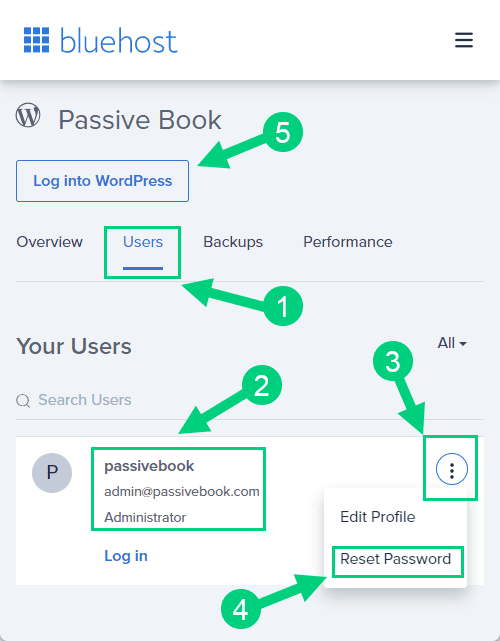
You can log into WordPress from the Bluehost dashboard by clicking the Log in to WordPress button ❺. But it is not recommended you rely on this as your primary login method because you will get locked out of your site if you ever change hosting providers.
17. You will be taken to the WordPress dashboard where you can reset your password ❶. If you don’t like the username Bluehost created for you, you can Add a New User ❷.

18. If you are adding a new user make sure you specify the user role as Administrator ❶. You can log in as the new user and safely delete the default user created by Bluehost.
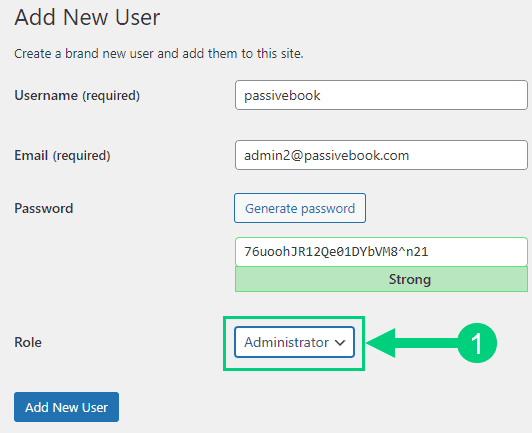
Congratulations! You have successfully set up WordPress.
Configure WordPress
Now that you have the basic version of WordPress installed, it is time to customize it to make it look and feel the way you want.
Login to WordPress Dashboard
Visit yourdomain.com/wp-admin to access the WordPress dashboard.

The WordPress Dashboard is where you will manage all the content on your website. You can add new posts and pages, change the settings of your website, add plugins and themes, and more.
Use the Email and Password you provided during installation to log in to your WordPress dashboard. If you don’t have a password, use the “Lost your password?” link to generate a new password.
Install WP Themes
A WordPress Theme is a collection of files that determine the look and feel of your website. When you install a WordPress theme, it will change the entire design and layout of your website.
Your new WordPress blog will be installed with a default blog theme that doesn’t look very great.
To install a new WordPress Theme:
Go to Appearance > Themes > Add New in your WordPress dashboard.
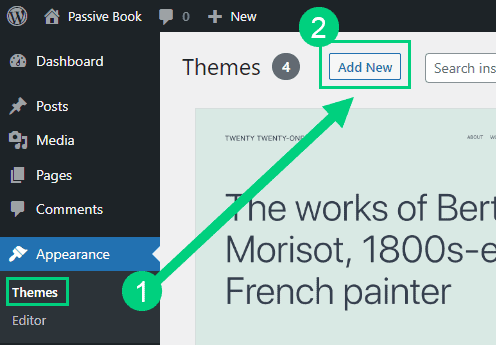
Use the search to find a theme that you like ❶. Before you install the theme, you can see a demo of the theme and learn about its features from the preview screen ❷. If you like the theme, you can install it by clicking the install button ❸. You can also upload a theme from a file on your computer ❹.
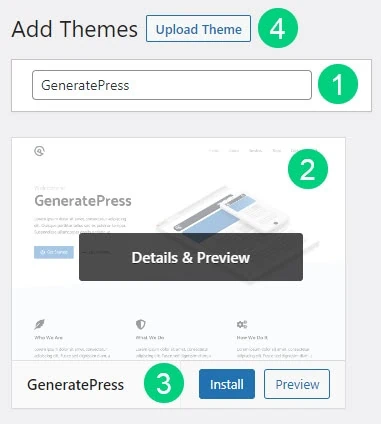
Once installed, click the Activate button to enable the theme.
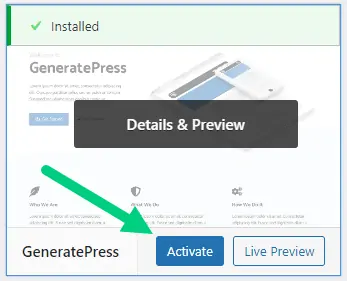
Although you can use a free theme (there are thousands of free themes available), we recommend using a premium theme.
Premium themes not only reduce your website’s load time but also help you customize your website to your heart’s desire.
Here are the premium themes we recommend:
There are also several custom-made weight loss blog themes. These themes tend to be bloated with poor code which will slow down the performance of your website. We suggest getting one of our recommended themes for a fast website with unlimited customization possibilities.
Install WP Plugins
A WordPress Plugin is a software application that adds features and functionality to WordPress. There are thousands of WordPress plugins available for free on the internet. But try to keep the number of plugins you install to a minimum because too many plugins can slow down your website.
Too many wordpress plugins can slow down your blog site. So before you install new plugins, it will be worth clearing out any existing plugins that your hosting provider installed by default.
Plugins first need to be deactivated before they can be deleted.
❶ Go to WP Admin > Plugins > Installed Plugins
❷ Click on the checkbox to select all plugins.
❸ Select Deactivate from the drop-down.
❹ Click Apply.
❺ Repeat the above steps but select “Delete” instead of “Deactivate” from the dropdown in ❸ to delete all the deactivated plugins.
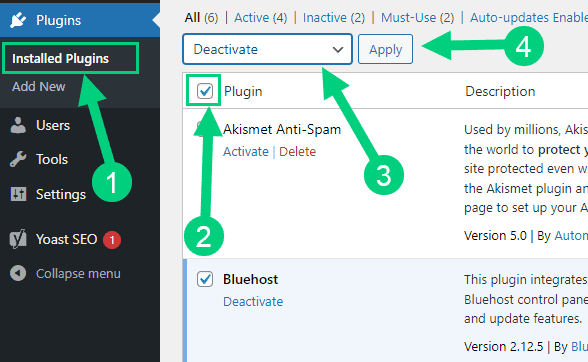
To install new plugins go to the WP Admin > Plugins > Add New.

On the plugins page:
❶ Search for the plugin you want in the search bar
❷ Click Install Now. Once you install the plugin, you must also activate the plugin for it to be enabled.
❸ If you are installing a paid plugin you can upload the plugin instead.

There are many different weight loss blog plugins that you can install, but here are the ones which we recommend:
Backup Plugin: A WordPress Backup Plugin is a software application that creates backups of your website so you can restore it in case something goes wrong.
Recommended Plugin: WPVivid (paid) or UpdraftPlus (free).
SEO Plugin: A WordPress SEO Plugin is a software application that helps you improve your website’s search engine ranking.
Recommended Plugin: RankMath (paid).
Google Analytics Plugin: A WordPress Google Analytics Plugin is a software application that helps you track your website’s traffic.
Recommended Plugin: RankMath (paid) or GA Google Analytics (free).
Cache Plugin: A WordPress Cache Plugin is a software application that stores a copy of your website’s static files (images, CSS, JavaScript) in a cache so that they can be served faster to your readers.
Recommended Plugin: WP Rocket (paid).
Page Builder Plugin: A WordPress Page Builder Plugin is a software application that helps you easily create custom pages and posts with drag and drop.
Recommended Plugin: Thrive Architect (paid).
Security Plugin: A WordPress Security Plugin is a software application that helps you secure your website from hackers and malware.
Recommended Plugin: Wordfence (free).
Social Media Plugin: A WordPress Social Share Plugin is a software application that helps you easily share your website content on social media platforms.
Recommended Plugin: Easy Social Share Buttons (paid).
Email List & Lead Generation Plugin: A WordPress Email Opt-in Form Plugin is a software application that helps you collect email addresses from your website visitors. When someone subscribes to your email list, you can send them promotional emails about your weight loss blog.
Recommended Plugin: Thrive Leads (paid).
Customize WordPress
Once you have installed your theme and plugins, it is time to customize the wordpress blog platform:
Change Colors, Fonts & Spacing
You can set the font, colors, and spacing by going to Appearance > Customize in your WordPress dashboard. Premium themes like GeneratePress allow you to customize every aspect of your blog.
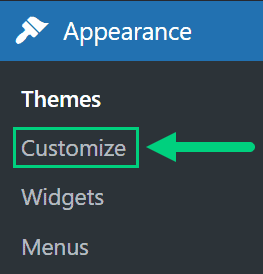
Check out our Blog Fonts & Typography guide to choose the right font and typography settings for your blog.
Add Your Logo
Get a logo designed for your blog from Fiverr. Then set the logo of your blog by going to Appearance > Customize in your WordPress dashboard. A logo is not required for a successful blog but it can definitely help appeal to your target audience.

Change Favicon
Favicon is the image that appears in the browser tab and bookmarks. Set the Favicon from the Appearance > Customize section of the WordPress dashboard.

Create Menus
The header and the footer menu can be set from the Appearance > Menus in your WordPress blog dashboard.

You can nest menu items so that it appears as a dropdown menu ❶. You can use the menu as your primary or secondary navigation menu ❷. Don’t forget to save your menu ❸.
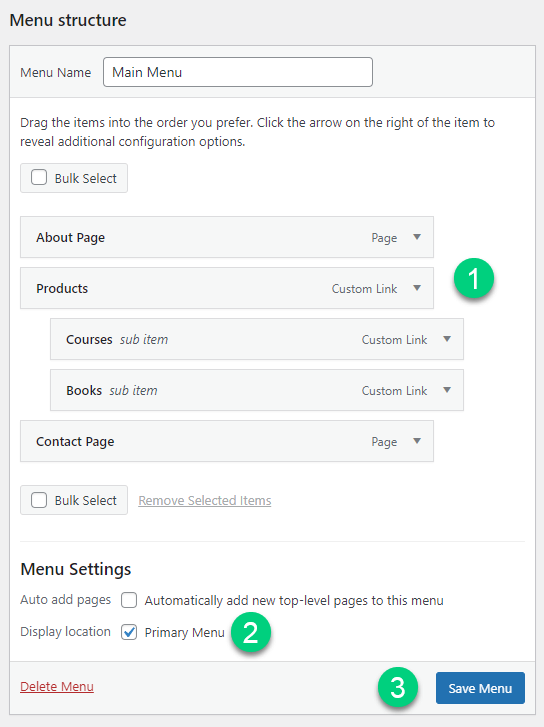
Create Widgets
If you have a sidebar, you can add widgets to it. Go to Appearance > Widgets in your WordPress admin dashboard.
Check out the list of the most useful Blog Widgets and how to add them to your blog.
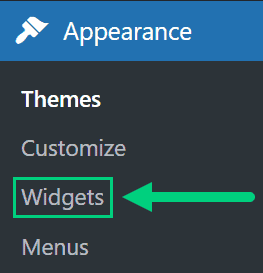
Set Title & Tag Line
The next step is to change your General Settings. Go to Settings > General in the WordPress Admin area.
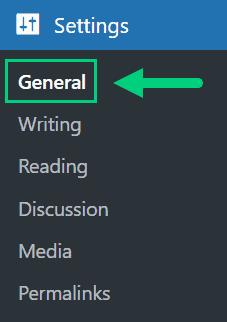
You can set your Site Title, Tagline, and Time Zone from this screen.
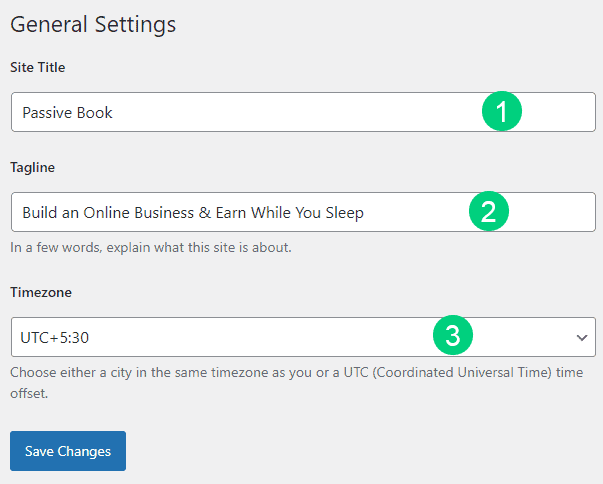
Set Permalinks
The ideal URL structure for SEO is yourdomain.com/sample-post. Set your permalink structure by going to Settings > Permalinks in your WordPress blog dashboard.
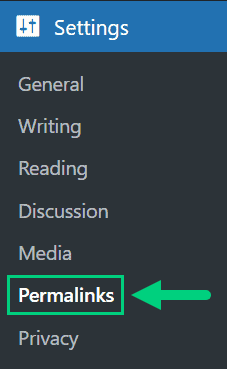
Select the “Post name” radio button and save changes.
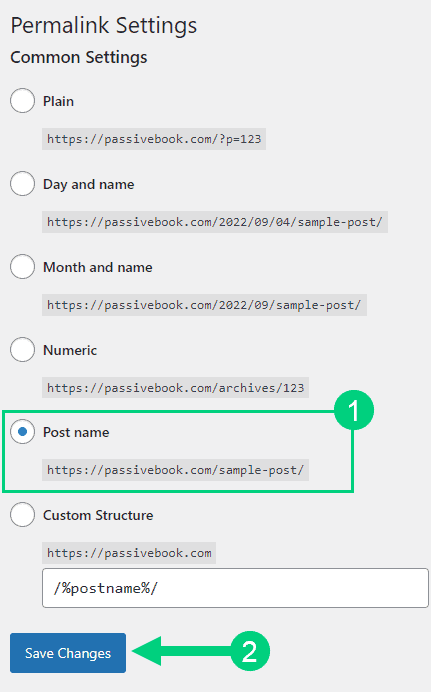
Enable Search Visibility
Chances are you want your blog to show up on Google so people can find you. Go to Settings > Reading in your WordPress dashboard.

To get search engine traffic, ensure the checkbox “Disable search engines from indexing this site” is Unchecked. You can find this option in Settings > Reading. Most of the time this should be unchecked by default but if it is not, then uncheck it to ensure your site gets traffic from search engines.
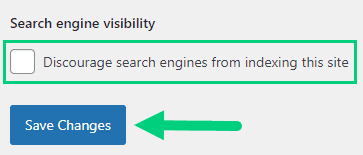
Adjust Comment Settings
Next, you will want to change the Discussion Setting (aka Comments). Go to Settings > Discussion in your WordPress admin area.
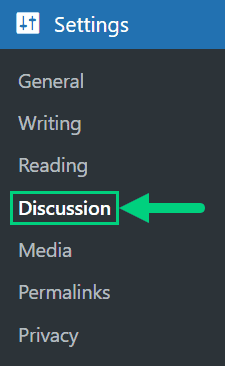
❶ You may want to enable or disable comments on this page. You can also disable pingbacks and enable comment moderation.
❷ You can also set comment approval settings.

If you want to design your blog further, check out our dedicated guide on blog design which has all our best blog design recommendations.
Create Static Pages
There are a few essential pages that you need to create for your weight loss blog before you can start blogging.
Use pages in WordPress to add static content. Go to WP Dashboard > Pages > Add New.
- Write the headline of your content.
- Populate the body content
- Click the publish button.
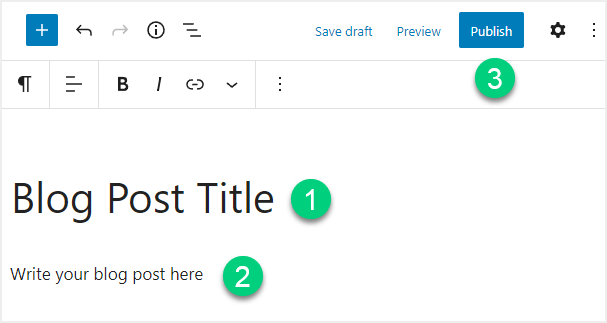
You may want to create the following pages:
Home Page
A home page is the main page of your website. It is usually the first page that your website visitors see when they visit your website. The home page typically contains a welcome message, a brief description of your website, and a list of your website’s most popular pages.

You can create a professional home page for your weight loss blog using a page builder like Thrive Architect.
About Page
An about page is a page on your website that tells your visitors who you are and what your website is about. It is usually one of the most popular pages on your website. It should include the following:
- A brief introduction to who you are
- What your blog is about
- What do you blog about specifically (weight loss, fitness, nutrition, etc.)
- Why you started your blog
- What your goals are for your blog
- A call to action (CTA)

Contact Page
A contact page is a page on your website where your visitors can contact you. It should include your email address, social media links, and a contact form.
Use contact form plugins like Fluent Forms to create the form on your contact page.
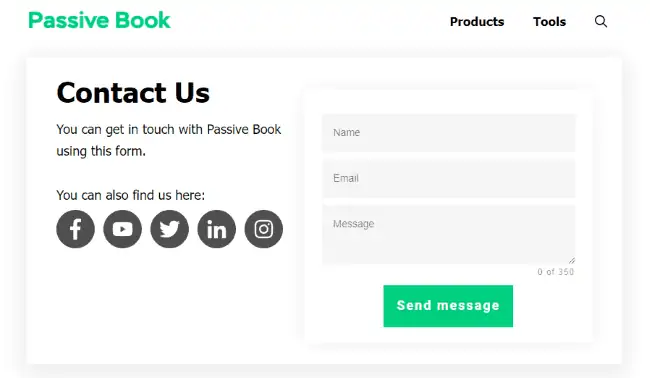
Privacy Policy
A privacy policy page is a page on your website where you tell your visitors how you use their personal information. It is required by law if you collect any personal information from your website visitors (such as email addresses).
WordPress generates its own privacy policy for you. But you can also use a tool like Termly to generate your own privacy policy.
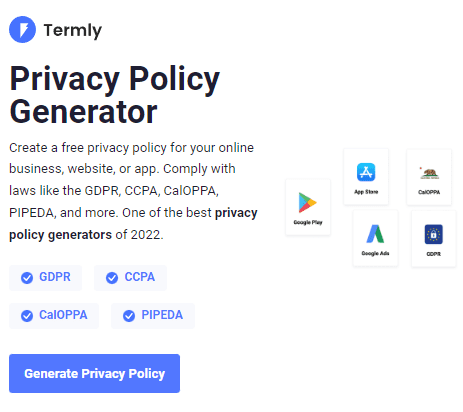
Terms of Service
A terms of service page is a page on your website where you tell your visitors what they can and cannot do on your website. It is required if you want to monetize your website with ads, affiliate marketing, or digital products.
Use a terms & conditions generator like Termly to create it.

5. Write & Publish Blog Posts
Now that you have your weight loss blog setup, it’s time to write and publish your first blog post. To craft the perfect blog post, check out our in-depth guide on How to Write A Blog Post. Here we will go over specific tips for a weight loss blog.
1. Brainstorm Topics
You should brainstorm 100 topic ideas for your weight loss blog. This will ensure that you always have content to write about in your weight loss blog.
The goal is to find topics for your weight loss blog that your audience is searching for on Google. The type of content you write on your weight loss blog will depend on your specific niche.
Here are a few weight loss blog post ideas, you can potentially cover in your weight loss blog:
- Recipes
- Workout Routines
- Meal Plans
- Weight Loss Tips
- Fitness Tips
- Nutrition Tips
- Before & After Stories
There are a few ways to brainstorm specific content:
Look at Competitors
If you’re a weight loss blogger, the best place to get content ideas is from your competition. It’s how I find most of my blog topics.
I usually start with Google and then check out how other bloggers are doing it on their sites. For example, if I want to write about paleo meal plans, I would go to Google and type in “paleo meal plans.”
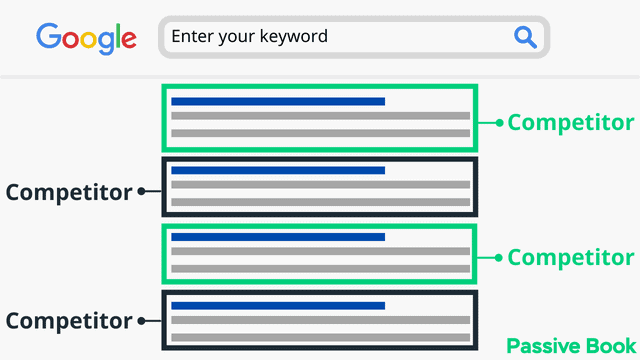
Then I would check out the top sites that come up and see how they are handling the topic. What type of content are they writing? Are they doing a good job? Is there anything you can do better?
Do Keyword Research
One great way to brainstorm content ideas for your weight loss blog is to use a tool like KeywordTool.io.
Keywordtool.io is a free keyword research tool that allows you to find keywords related to your topic.
To use Keywordtool.io, simply enter a keyword or phrase into the search bar and it will generate a list of related keywords.
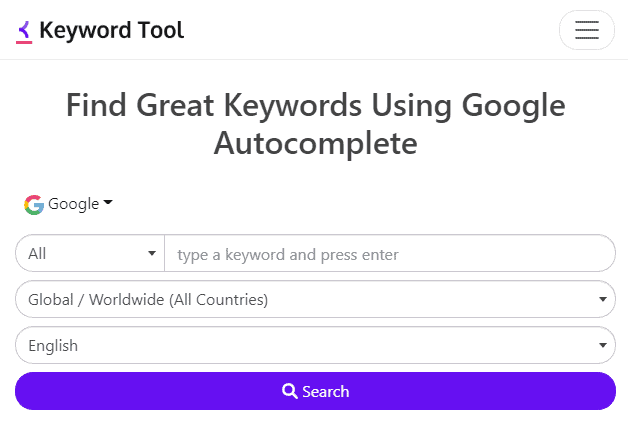
For example, if I enter the keyword “weight loss” into Keywordtool.io, it generates a list of related keywords, such as “weight loss tips,” “weight loss transformations,” and “weight loss journeys.”
You can then use these keywords to brainstorm content ideas for your weight loss blog.
Community & Forums
One of the best ways to get content ideas for your weight loss blog is to join a community or forum related to your topic.
This way, you can get ideas from other bloggers, learn from their experiences, and connect with others in your niche.
The two best places to find online communities and forums are Facebook Groups and Reddit.
Both Facebook Groups and Reddit have a ton of online communities and forums for every topic imaginable.
To find relevant groups and forums for your weight loss blog, simply go to Facebook Groups or Reddit and search for your topic.
You can also use Quora to find content ideas for your weight loss blog.
2. Create an Editorial Calendar
An editorial calendar is a tool that allows you to plan, organize, and schedule your blog posts. It is an essential tool for bloggers because it helps them stay organized and on track.
The benefits of using an editorial calendar are:
- It helps you plan, organize, and schedule your blog posts.
- It enables you to optimize your content calendar for SEO.
- It helps you keep track of your publishing deadlines.
An editorial calendar should include the following information:
- Post Title
- Planned Publish Date
- URL
- Keywords
- Description
- Author
Download Content Calendar Template

Steal our exclusive content calendar template. Have it delivered directly to your inbox:
There are a few different ways to create an editorial calendar. You can use Google Sheets, Excel spreadsheet, or a tool like Trello.
3. Write a Blog Post
Now that you have a list of content ideas and an editorial calendar, it’s time to start writing your blog post.
Write 5x Faster With AI
You can write your new blog post at 5x speed using the AI writing software Jasper. I was able to write over a hundred blog articles in 3 months using Jasper. This blog article you are reading right now was written with the help of Jasper. AI will not only help you write blog posts fast but also with higher quality.
Jasper can write plagiarism-free blog content, articles, social media content, emails, and ad copy. All you have to do is provide a few inputs on what you want and Jasper will do all the hard work of creating the blog content for you. No more writer’s block.
Check out the video below to see Jasper in action:
Try Jasper for free using the links on this page and get 10,000 bonus credits you can use to start writing your first articles.
Once you sign up for Jasper I recommend you spend some time going through the tutorial videos in the Jasper Bootcamp to truly unlock the power of this amazing software.
Check out our guide on How to Write a Blog Post Fast in 15 mins Without Losing Quality for more tips to write fast.
Personal Weight Loss Journey
Personal weight loss journey posts are a type of blog post where the blogger shares their personal experience with losing weight. They often include details about the blogger’s struggles, successes, and the methods they used to achieve their weight loss goals. This type of post is popular because readers can relate to the blogger’s experience and find inspiration in their journey to sustainable weight loss.
Here are a few examples:
- “My 100-pound weight loss journey: How I did it”
- “From couch potato to marathon runner: My weight loss story”
- “The ups and downs of my weight loss journey: A year in review”
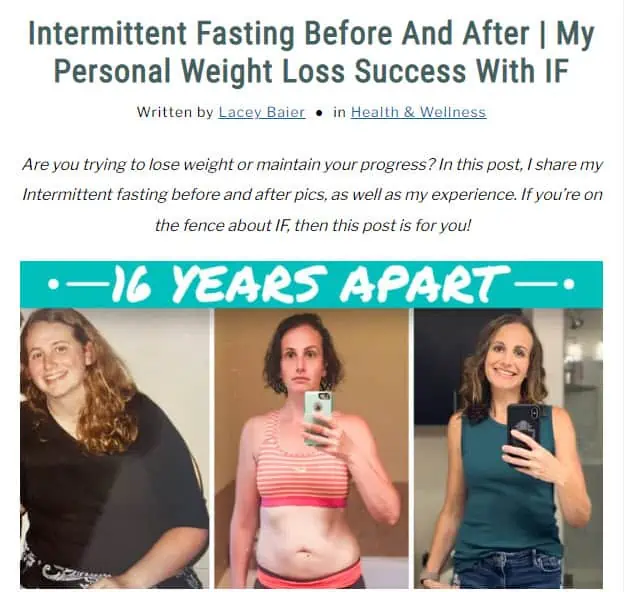
When writing a personal weight loss journey post, it’s important, to be honest and transparent about your experience in reaching your goal weight. Share the good and the bad, and be specific about the methods you used to achieve your weight loss goals. Also, readers find it inspiring to know the struggles you faced and how you overcame them. Including before and after photos can also be a great way to demonstrate your progress and inspire readers.
Writing Recipes
Recipes are blog posts that provide information on healthy recipes that can help readers lose weight. They often include information on different types of foods, meal plans, and healthy recipes.
Here are a few examples:
- “10 easy and delicious healthy recipes for weight loss”
- “Healthy recipe ideas for breakfast, lunch, and dinner”
- “Healthy recipe alternatives for popular but unhealthy foods”
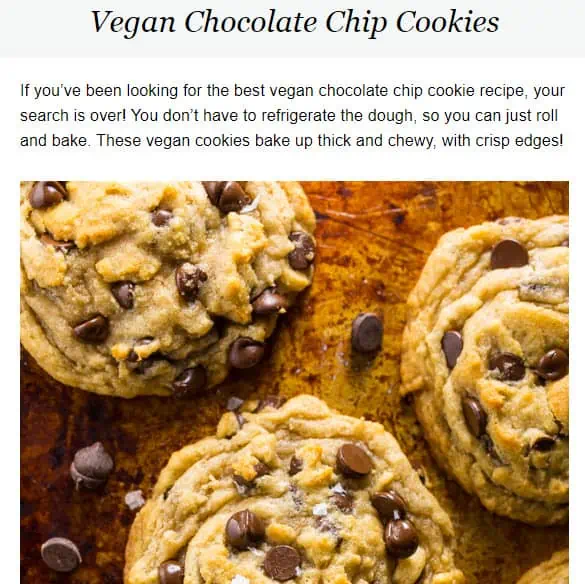
Provide a variety of options for different dietary preferences and restrictions. Additionally, providing tips for meal prepping and meal planning can be helpful for readers. Furthermore, including nutritional information for each recipe can be beneficial for readers. Make sure to focus on making it easy to follow. Include clear instructions and use plenty of images.
If you’re going to write a recipe, there are a few things you need to include:
- Ingredients
- Instructions
- Nutritional Information
- Images
- Tools & Equipment Needed
Writing Workout Routines
Exercise and workout tips are blog posts that provide information on how to effectively exercise and work out for weight loss. They often include information on different types of exercises, workout routines, and tips for staying motivated.
Here are a few examples:
- “The ultimate full-body workout for weight loss”
- “5 easy exercises for a busy person to lose weight”
- “The best exercises for targeting belly fat”

When writing exercise and workout tips, it’s important to provide clear and detailed instructions for the exercises and workouts you recommend. Also, it’s good to include photos or videos to demonstrate the exercises correctly.
Additionally, providing modifications for different fitness levels can be helpful for readers. Furthermore, providing tips for staying motivated and overcoming exercise-related obstacles can be beneficial for readers.
If you’re going to write a workout routine, there are a few things you need to include:
- A list of exercises
- Instructions on how to perform the exercises
- Images or videos of the exercises being performed
- The number of sets and reps for each exercise
- The amount of time needed to complete the workout
Product & Program Reviews
You can share your experience with a specific weight loss product or program. This type of post can help readers make informed decisions about which products or programs to try.
Here are a few examples:
- “My review of the X weight loss program: Is it worth the investment?”
- “The truth about the Y weight loss supplement: My personal experience”
- “Weight loss product review: The pros and cons of Z”

When writing reviews of weight loss products or programs, it’s important to be objective and provide both the positive and negative aspects of the product or program. Also, it’s good to have some research and back up your review with facts, figures, and studies. Furthermore, including before and after photos can be a great way to demonstrate the effectiveness of the product or program.
Success Stories
Success stories and testimonials from other weight loss bloggers or readers are blog posts where the blogger shares stories of weight loss success from other bloggers or readers. These posts can be used as inspiration and motivation for readers who are trying to lose weight themselves.
Here are a few examples:
- “Real weight loss success stories from our readers”
- “From overweight to fit: A weight loss success story from a fellow blogger”
- “Before and after: Inspiring weight loss transformations from our community”

When writing success stories and testimonials, it’s important to get permission from the person whose story you are sharing and to make sure that their story is accurate and truthful. Also, it’s good to include details about the methods and strategies used by the person to achieve their weight loss goals. Additionally, including before and after photos can be a great way to demonstrate the person’s progress and inspire readers. Conclude your post by encouraging your readers to share their own success stories with you.
Science & Research Explanation
These blog posts provide information on the scientific principles behind weight loss. These posts can help readers understand the mechanisms of weight loss and make informed decisions about their own weight loss journeys.
- “The science of weight loss: How your body burns fat”
- “The truth about metabolism and weight loss”
- “Weight loss myths debunked: Separating fact from fiction”

When writing about weight loss science and research, it’s important to provide accurate and reliable information based on scientific studies and research. Also, it’s good to explain the information in a clear and easy-to-understand manner for readers.
Providing sources and references for the information can be helpful for readers who want to read more on the topic. Furthermore, providing your own insights and opinion can help readers to understand and relate to the information better.
Progress Tracking
Weight Loss progress tracking is a type of blog post where the blogger shares their progress and updates on their weight loss journey, including information on their weight, measurements, and any other relevant data. These posts can provide inspiration and motivation for readers who are also trying to lose weight.
Examples include:
- “My weight loss progress update: 12 weeks in”
- “Before and after: My progress so far”
- “My measurements: How my body has changed”
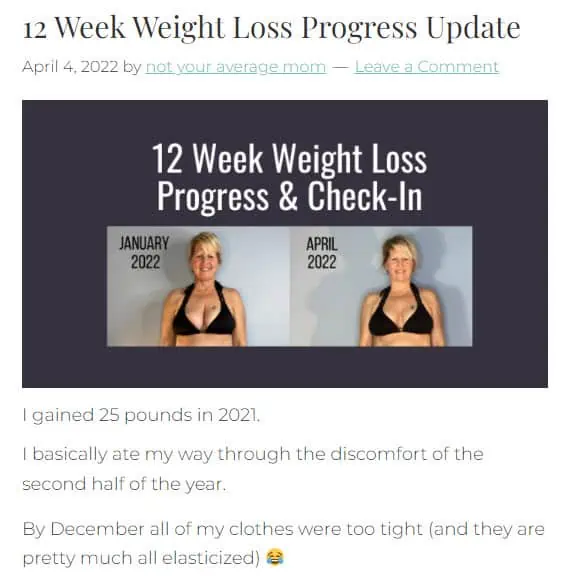
When writing progress-tracking posts, it’s important, to be honest and transparent about your progress, including both the positive and negative aspects of your journey. Also, it’s good to include photos or other visual aids to demonstrate your progress and inspire readers. Provide tips and advice for tracking progress and setting weight loss goals so your readers can apply them to their own lives.
Challenge Posts
Challenges and accountability posts are blog posts that encourage readers to participate in a specific weight loss challenge, typically for a certain period. These challenges can include a specific workout plan, meal plan, or other weight loss goal. These challenges can help readers stay motivated and accountable while working towards their weight loss goals.
Here are a few examples
- “30-day weight loss challenge: Are you up for the challenge?”
- “The summer slimdown challenge: Let’s get beach body ready”
- “The no-sugar challenge: Can you go 30 days without added sugar?”

When writing challenges and accountability posts, it’s important to provide clear and specific instructions and guidelines for the challenge. Also, it’s good to provide a way for readers to track their progress and share their results with others, such as a private Facebook group or a commenting section on the blog post.
Providing a way for readers to share their own challenges and successes can be beneficial for the blog and the community.
Meal Plans
Meal Plans are blog posts that provide information on healthy meal planning that can help readers lose weight. They often include information on different types of foods, meal plans, and healthy recipes.
- “The ultimate guide to healthy meal planning for weight loss”
- “Meal planning 101: How to plan your meals for weight loss”
- “The truth about carbs and weight loss: What you need to know”

It’s good to provide a variety of options for different dietary preferences and restrictions. Additionally, providing tips for meal prepping and meal planning can be helpful for readers. Furthermore, providing a sample meal plan with a grocery list can be beneficial for readers.
If you’re going to write a meal plan, there are a few things you need to include:
- A list of recipes
- Instructions on how to prepare the recipes
- Images of the meals being prepared
- The number of servings for each recipe
- The amount of time needed to prepare the meals
Outsource Writing
If you don’t have the time or skills to write blog posts yourself, you can always outsource writing services.
There are several different places where you can find freelance writers, such as:
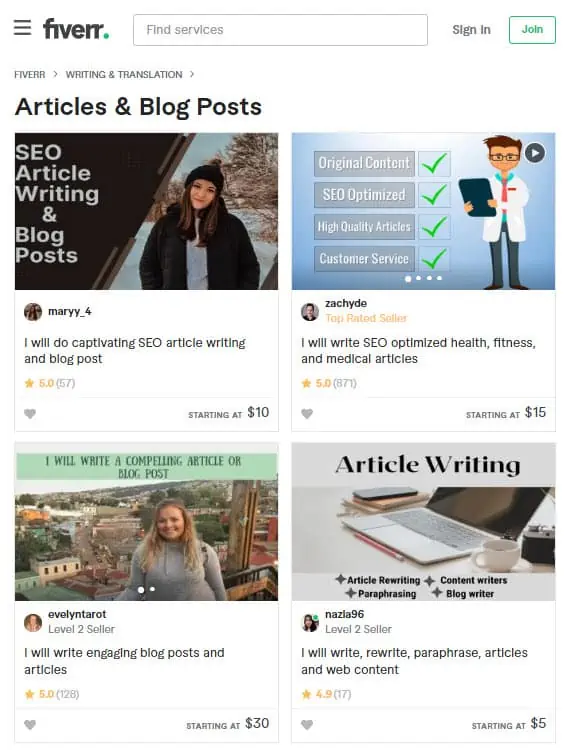
4. Add Images
Images are an essential part of any blog post. They help break up the text and make your posts more visually appealing.
When selecting images for your blog posts, make sure to choose high-quality images that are relevant to the topic of your post. However, finding high-quality images can be difficult and expensive.
That’s why it’s a good idea to take your own photos. Not only will you have control over the quality of the image, but you’ll also be able to customize it to match the look and feel of your blog.
To get started, invest in a good camera and learn how to use it. You can also use your smartphone camera to get started. Then, start taking photos of your meals, workouts, and everyday life.
You can also find stock photos on sites like:
Free Options: Pixabay, Pexels, Upsplash
Paid Options: Deposit Photos, Shutterstock, iStock, Getty Images, 123rf.
Once you have some images, you’ll need to edit them in a photo editing app like Canva.
You may also want to upgrade to Canva Pro because it offers a library of stock images that you can use in your blog posts. The library includes high-quality photos from professional photographers, as well as illustrations and icons. Plus, you can use the library to create custom images for your blog.
6. Promote Your Weight Loss Blog
Now that you have a few blog posts written and published, it’s time to start promoting your blog.
There are several different ways to promote your weight loss blog, such as:
Search Engine Optimization (SEO)
SEO is the process of optimizing your website to rank higher in search engine results pages.
In SEO, you need to optimize for the following:
- Title Tags
- Meta Descriptions
- Headings
- Internal Links
- External Links
Many factors go into SEO, and it can be a bit confusing to figure out where to start. You can master the more advanced SEO tactics by checking out our SEO Resources.

You can ensure you get the basics of SEO right, by completing the recommendations given by the RankMath plugin.
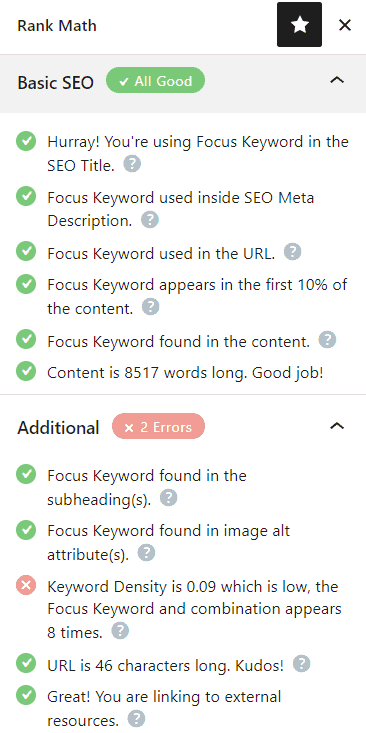
Email Marketing
Email marketing is a great way to connect with your readers and promote your content. You need to create an opt-in form to collect email addresses and then connect it with an email marketing service to send out emails.
Once you have a list of email subscribers, you can start sending out emails with links to your latest blog posts, as well as other valuable content.
You can also use email marketing to promote products and services that you recommend to your readers.

You can use the Thrive Leads plugin to build opt-in forms to collect email addresses. You can then connect the opt-in form to an email marketing service like Active Campaign to send out the emails.
Check out our Email Marketing resources to learn more.
Social Media Marketing
Social media is a great way to connect with your readers and promote your content.
When promoting your blog posts on social media, make sure to use high-quality images, as well as engaging descriptions and headlines.
You should also consider using social media ads to promote your content, as they can be very effective.
Guest blogging
Guest blogging is a great way to get exposure for your blog and build backlinks to your website.
When guest blogging, you write a blog post for another website in your niche. In your guest post, you include a link back to your own website. You can also promote your blog from your author bio.
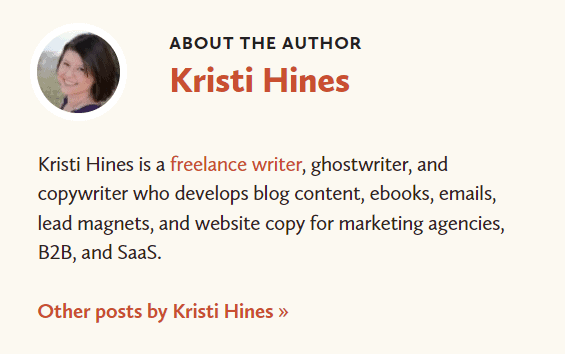
This helps to promote your website and improve your SEO.
To find guest blogging opportunities, you can search Google for “keyword” + “write for us” or “keyword” + “submit a guest post.”
7. Monetize & Make Money
There are several different ways that you can monetize your weight loss blog.
Advertising
One way to monetize your weight loss blog is to use advertising.
Advertising allows you to make money by displaying ads on your blog. When someone clicks on an ad, you earn money.
To start advertising on your blog, you can sign up for an ad network like Ezoic (they pay more than Google Adsense). When your blog starts getting more than 100,000 page views a month you can monetize with Adthrive.
| Ad Network | Earnings Per 1K Impressions (EPM) | Monthly Traffic Requirement |
|---|---|---|
| Ad Thrive | $13 | 100,000 |
| Ezoic | $3 | 10,000 |
| Media.net | $1 | – |
| Google Adsense | $1 | – |
Affiliate Marketing
Affiliate marketing is a great way to monetize your weight loss blog.
With affiliate marketing, you promote products and services on your blog and earn a commission when someone buys something through your affiliate link.
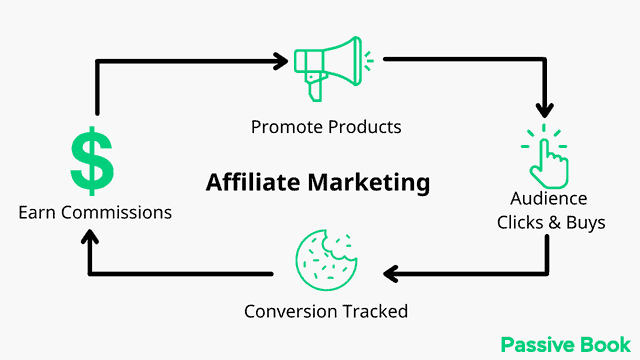
To get started with affiliate marketing, you need to find products and services that you can promote on your blog.
Then, you need to sign up for an affiliate program. Once you’re approved, you’ll be given an affiliate link that you can use to promote the product or service on your blog.
Digital Products
Another way to monetize your weight loss blog is to sell digital products.
Digital products are products that are delivered electronically, such as ebooks, courses, and software.
Creating and selling digital products is a great way to make money online, as it allows you to leverage your knowledge and expertise to create products that people will be willing to pay for.
To get started with selling digital products, you need to choose a product to sell, create the product, and then find a platform to sell it on.
You can use Teachable if you want to sell video courses. Your students will have a dedicated course members area and a community system to ask questions and interact with each other. If you only want to sell eBooks, you can use SendOwl which lets you sell your digital products and eBooks for free.
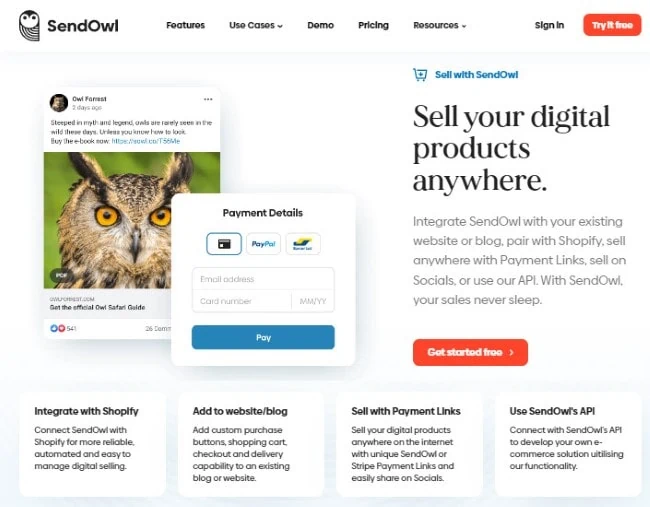
Sell Services
Another way to monetize your weight loss blog is to sell services.
This could be anything from coaching and consulting to writing and design.

If you have a skill or expertise that you can offer others, then selling services is a great way to monetize your weight loss blog.
To get started with selling services, you need to choose a service to offer, create a sales page for the service, and then find clients.
FAQ
Can I make money with a weight loss blog?
Yes, you can make money with a weight loss blog. There are several different ways that you can monetize your weight loss blog, such as selling advertising space, affiliate marketing, digital products, and services.
Should I blog about my weight loss?
There is no definitive answer to this question. You will need to weigh the pros and cons of blogging your weight loss journey before making a decision.
Some things to consider include whether or not you are comfortable sharing your story publicly and, how much time you are willing to dedicate to maintaining a blog.
How do I start a weight loss journey journal?
Starting a weight loss journey journal is a great way to document your progress and stay motivated. To get started, you will need to choose a platform to journal on. You can use a traditional journal or notebook, or you can use an online platform like WordPress. Once you have chosen a platform, you will need to start writing down your thoughts, feelings, and experiences.
What Next?
Hope you found this ultimate guide to starting a weight loss blog useful.
If you have any questions as you set up your new blog, leave a comment below so we can help you out.
There are plenty of options out there when it comes to weight loss. Unfortunately, many of these options require expensive programs or equipment, and they may not even work.
Your weight loss blog can be both an affordable and effective way that inspires others to lose weight.
Have you started your weight loss blog yet? What type of weight loss blog are you going to start? Let us know in the comments below.
Share this post with your friends & followers:
